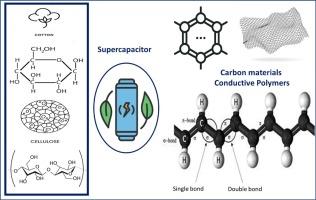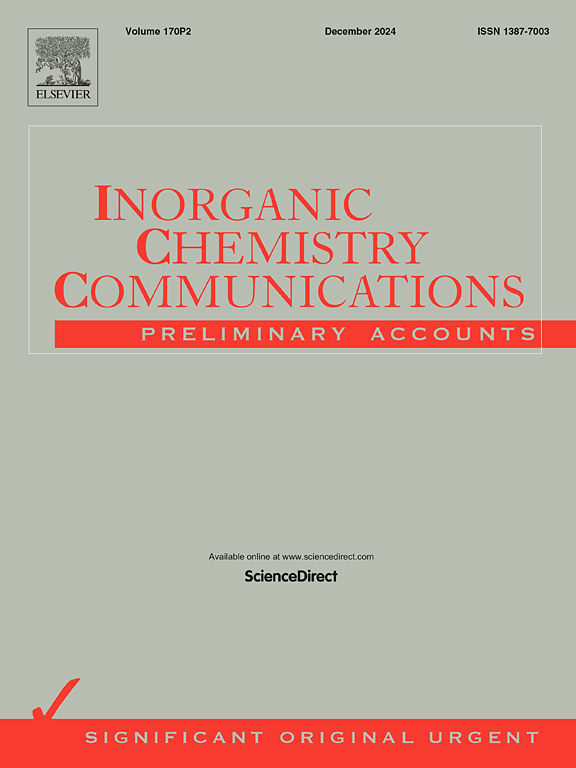用于超级电容器基碳材料和导电聚合物的棉花和纤维素
IF 4.4
3区 化学
Q1 CHEMISTRY, INORGANIC & NUCLEAR
引用次数: 0
摘要
棉纤维是纤维素的一种天然形式,由于其耐磨性、可集成性、环保性和成本效益,在开发可穿戴储能设备方面发挥着举足轻重的作用。棉花源自植物纤维素,因其在轻型可穿戴电子设备(尤其是储能系统)中的潜力而备受关注,以满足人们对可穿戴电子纺织品日益增长的需求。可穿戴性、环境可持续性、经济性和卓越的电化学性能,这些因素的结合极大地增强了棉基储能设备的潜力。棉花的独特结构提供了较大的表面积,为装载活性材料、促进电荷/离子转移和高效离子迁移创造了理想的平台。这些特性使棉花和纤维素基纤维在制造一维(1D)超级电容器方面非常有效,表现出卓越的电化学、机械和耐磨性能。然而,棉花固有的电绝缘性限制了其在储能应用中的有效性。在棉花不导电的表面涂覆或嵌入活性导电材料的难题已通过各种方法得到解决。导电聚合物是一种用途广泛的多功能材料,为解决储能领域的各种难题提供了前景广阔的解决方案。本综述广泛探讨了导电聚合物在超级电容器中的应用。最后,我们讨论了这一令人兴奋且发展迅速的领域所面临的挑战和未来前景。本文章由计算机程序翻译,如有差异,请以英文原文为准。

Cotton and cellulose for supercapacitor-based carbon materials and conductive polymers
Cotton fibres, a natural form of cellulose, have played a pivotal role in developing wearable energy storage devices due to their wearability, integrability, environmental friendliness, and cost-effectiveness. Derived from plant cellulose, cotton has garnered significant attention for its potential in lightweight and wearable electronic devices, particularly energy storage systems, to meet the growing demand for wearable e-textiles. The combination of wearability, environmental sustainability, affordability, and superior electrochemical performance dramatically enhances the potential of cotton-based energy storage devices. The unique structure of cotton provides a large surface area, creating an ideal platform for loading active materials, facilitating charge/ion transfer, and promoting efficient ion migration. These characteristics make cotton and cellulose-based fibres highly effective in fabricating one-dimensional (1D) supercapacitors, demonstrating excellent electrochemical, mechanical, and wearable performance.
However, the intrinsic electrical insulation of cotton limits its effectiveness in energy storage applications. The challenge of coating or embedding active and conductive materials onto cotton’s nonconductive surface has been overcome by various tactics. Conductive polymers, being versatile and multifunctional materials, offer promising solutions to revolutionize industries by addressing diverse challenges in energy storage. The application of conductive polymers in supercapacitors is explored extensively in this review. Finally, we discuss the challenges and future perspectives in this exciting and rapidly evolving field.
求助全文
通过发布文献求助,成功后即可免费获取论文全文。
去求助
来源期刊

Inorganic Chemistry Communications
化学-无机化学与核化学
CiteScore
5.50
自引率
7.90%
发文量
1013
审稿时长
53 days
期刊介绍:
Launched in January 1998, Inorganic Chemistry Communications is an international journal dedicated to the rapid publication of short communications in the major areas of inorganic, organometallic and supramolecular chemistry. Topics include synthetic and reaction chemistry, kinetics and mechanisms of reactions, bioinorganic chemistry, photochemistry and the use of metal and organometallic compounds in stoichiometric and catalytic synthesis or organic compounds.
 求助内容:
求助内容: 应助结果提醒方式:
应助结果提醒方式:


